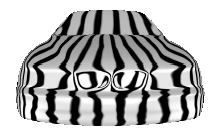Profile

|
Dr. Loïc Barthe |
Publications
Subdivision Scheme Tuning Around Extraordinary Vertices

In this paper we extend the standard method to derive and optimize subdivision rules in the vicinity of extraordinary vertices (EV). Starting from a given set of rules for regular control meshes, we tune the extraordinary rules (ER) such that the necessary conditions for C1 continuity are satisfied along with as many necessary C2 conditions as possible. As usually done, our approach sets up the general configuration around an EV by exploiting rotational symmetry and reformulating the subdivision rules in terms of the subdivision matrix' eigencomponents. The degrees of freedom are then successively eliminated by imposing new constraints which allows us, e.g., to improve the curvature behavior around EVs. The method is flexible enough to simultaneously optimize several subdivision rules, i.e. not only the one for the EV itself but also the rules for its direct neighbors. Moreover it allows us to prescribe the stencils for the ERs and naturally blends them with the regular rules that are applied away from the EV. All the constraints are combined in an optimization scheme that searches in the space of feasible subdivision schemes for a candidate which satisfies some necessary conditions exactly and other conditions approximately. The relative weighting of the constraints allows us to tune the properties of the subdivision scheme according to application specific requirements. We demonstrate our method by tuning the ERs for the well-known Loop scheme and by deriving ERs for a \sqrt{3}-type scheme based on a 6-direction Box-spline.
Direct computation of a control vertex position on any subdivision level

In this paper, we present general closed form equations for directly computing the position of a vertex at different subdivision levels for both triangular and quadrilateral meshes. These results are obtained using simple computations and they lead to very useful applications, especially for adaptive subdivision. We illustrate our method on Loop's and Catmull-Clark's subdivision schemes.

